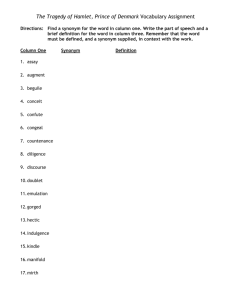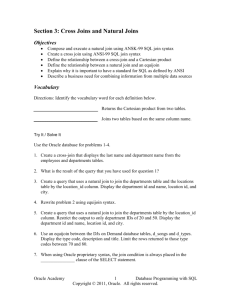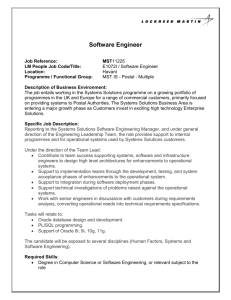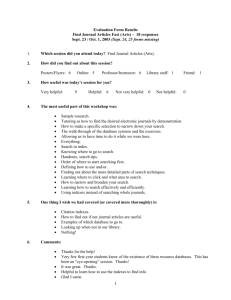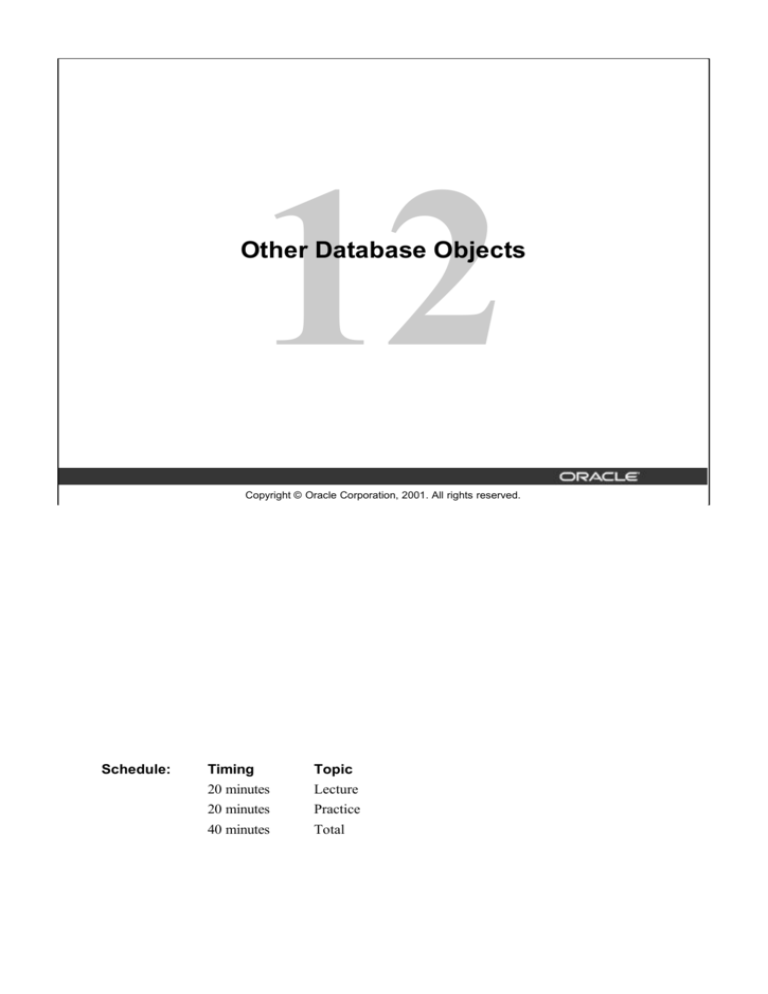
12
Other Database Objects
Copyright © Oracle Corporation, 2001. All rights reserved.
Schedule:
Timing
20 minutes
Topic
Lecture
20 minutes
Practice
40 minutes
Total
Objectives
After completing this lesson, you should be able to
do the following:
•
•
•
12-2
Create, maintain, and use sequences
Create and maintain indexes
Create private and public synonyms
Copyright © Oracle Corporation, 2001. All rights reserved.
Lesson Aim
In this lesson, you learn how to create and maintain some of the other commonly used database
objects. These objects include sequences, indexes, and synonyms.
Introduction to Oracle9i: SQL 12-2
Database Objects
12-3
Object
Description
Table
Basic unit of storage; composed of rows
and columns
View
Logically represents subsets of data from
one or more tables
Sequence
Generates primary key values
Index
Improves the performance of some queries
Synonym
Alternative name for an object
Copyright © Oracle Corporation, 2001. All rights reserved.
Database Objects
Many applications require the use of unique numbers as primary key values. You can either build
code into the application to handle this requirement or use a sequence to generate unique numbers.
If you want to improve the performance of some queries, you should consider creating an index.
You can also use indexes to enforce uniqueness on a column or a collection of columns.
You can provide alternative names for objects by using synonyms.
Introduction to Oracle9i: SQL 12-3
What Is a Sequence?
A sequence:
•
•
•
•
•
12-4
Automatically generates unique numbers
Is a sharable object
Is typically used to create a primary key value
Replaces application code
Speeds up the efficiency of accessing sequence
values when cached in memory
Copyright © Oracle Corporation, 2001. All rights reserved.
What Is a Sequence?
A sequence is a user created database object that can be shared by multiple users to generate unique
integers.
A typical usage for sequences is to create a primary key value, which must be unique for each row.
The sequence is generated and incremented (or decremented) by an internal Oracle routine. This
can be a time-saving object because it can reduce the amount of application code needed to write a
sequence-generating routine.
Sequence numbers are stored and generated independently of table s. Therefore, the same sequence
can be used for multiple tables.
Introduction to Oracle9i: SQL 12-4
The CREATE SEQUENCE Statement Syntax
Define a sequence to generate sequential numbers
automatically:
CREATE SEQUENCE sequence
[INCREMENT BY n]
[START WITH n]
[{MAXVALUE n | NOMAXVALUE}]
[{MINVALUE n | NOMINVALUE}]
[{CYCLE | NOCYCLE}]
[{CACHE n | NOCACHE}];
Copyright © Oracle Corporation, 2001. All rights reserved.
12-5
Creating a Sequence
Automatically generate sequential numbers by using the CREATE SEQUENCE statement.
In the syntax:
sequence
is the name of the sequence generator
INCREMENT BY n
specifies the interval between sequence numbers where n is an
integer (If this clause is omitted, the sequence increments by
START WITH n
specifies the first sequence number to be generated (If this cla use is
omitted, the sequence starts with 1.)
MAXVALUE n
specifies the maximum value the sequence can generate
NOMAXVALUE
specifies a maximum value of 10^27 for an ascending sequence and
–1 for a descending sequence (This is the default option.)
MINVALUE n
specifies the minimum sequence value
NOMINVALUE
specifies a minimum value of 1 for an ascending sequence and –
(10^26) for a descending sequence (This is the default
1.)
option.)
specifies whether the sequence continues to generate values after
reaching its maximum or minimum value (NOCYCLE is the
option.)
CYCLE | NOCYCLE
default
specifies how many values the Oracle server preallocates and
keep in memory (By default, the Oracle server caches 20
Introduction to Oracle9i: SQL 12-5
CACHE n | NOCACHE
values.)
Creating a Sequence
•
•
Create a sequence named DEPT_DEPTID_SEQ to
be used for the primary key of the DEPARTMENTS
table.
Do not use the CYCLE option.
CREATE SEQUENCE dept_deptid_seq
INCREMENT BY 10
START WITH 120
MAXVALUE 9999
NOCACHE
NOCYCLE;
Sequence created.
12-6
Copyright © Oracle Corporation, 2001. All rights reserved.
Creating a Sequence (continued)
The example on the slide creates a sequence named DEPT_DEPTID_SEQ to be used for the
DEPARTMENT_ID column of the DEPARTMENTS table. The sequence starts at 120, does not
allow caching, and does not cycle.
Do not use the CYCLE option if the sequence is used to generate primary key values, unless you
have a reliable mechanism that purges old rows faster than the sequence cycles.
For more information, see Oracle9i SQL Reference, “CREATE SEQUENCE.”
Note: The sequence is not tied to a table. Generally, you should name the sequence after its
intended use; however the sequence can be used anywhere, regardless of its name.
Instructor Note
If the INCREMENT BY value is negative, the sequence descends. Also, ORDER | NOORDER
options are available. The ORDER option guarantees that sequence values are generated in order. It
is not important if you use the sequence to generate primary key values. This option is relevant
only with the Parallel Server option.
If sequence values are cached, they will be lost if there is a system failure.
Introduction to Oracle9i: SQL 12-6
Confirming Sequences
•
Verify your sequence values in the
USER_SEQUENCES data dictionary table.
SELECT
FROM
•
12-7
sequence_name, min_value, max_value,
increment_by, last_number
user_sequences;
The LAST_NUMBER column displays the next
available sequence number if NOCACHE is
specified.
Copyright © Oracle Corporation, 2001. All rights reserved.
Confirming Sequences
Once you have created your sequence, it is documented in the data dictionary. Since a sequence is
a database object, you can identify it in the USER_OBJECTS data dictionary table.
You can also confirm the settings of the sequence by selecting from the USER_SEQUENCES data
dictionary view.
Instructor Note
Demo: 12_dd.sql
Purpose: To illustrate the USER_SEQUENCES data dictionary view and its contents.
Introduction to Oracle9i: SQL 12-7
NEXTVAL and CURRVAL Pseudocolumns
•
•
•
12-8
NEXTVAL returns the next available sequence
value. It returns a unique value every time it is
referenced, even for different users.
CURRVAL obtains the current sequence value.
NEXTVAL must be issued for that sequence before
CURRVAL contains a value.
Copyright © Oracle Corporation, 2001. All rights reserved.
Using a Sequence
After you create your sequence, it generates sequential numbers for use in your tables. Reference
the sequence values by using the NEXTVAL and CURRVAL pseudocolumns.
NEXTVAL and CURRVAL Pseudocolumns
The NEXTVAL pseudocolumn is used to extract successive sequence numbers from a specified
sequence. You must qualify NEXTVAL with the sequence name. When you reference
sequence.NEXTVAL, a new sequence number is generated and the current sequence number is
placed in CURRVAL.
The CURRVAL pseudocolumn is used to refer to a sequence number that the current user has just
generated. NEXTVAL must be used to generate a sequence number in the current user’s session
before CURRVAL can be referenced. You must qualify CURRVAL with the sequence name. When
sequence.CURRVAL is referenced, the last value returned to that user’s process is displayed.
Introduction to Oracle9i: SQL 12-8
Rules for Using NEXTVAL and CURRVAL
You can use NEXTVAL and CURRVAL in the following contexts:
•
The SELECT list of a SELECT statement that is not part of a subquery
•
The SELECT list of a subquery in an INSERT statement
•
The VALUES clause of an INSERT statement
•
The SET clause of an UPDATE statement
You cannot use NEXTVAL and CURRVAL in the following contexts:
•
The SELECT list of a view
•
A SELECT statement with the DISTINCT keyword
•
A SELECT statement with GROUP BY, HAVING, or ORDER BY clauses
•
A subquery in a SELECT, DELETE, or UPDATE statement
•
The DEFAULT expression in a CREATE TABLE or ALTER TABLE statement
For more information, see Oracle9i SQL Reference, “Pseudocolumns” section and “CREATE
SEQUENCE.”
Instructor Note
Be sure to point out the rules listed on this page.
Introduction to Oracle9i: SQL 12-9
Using a Sequence
•
Insert a new department named “Support” in
location ID 2500.
INSERT INTO departments(department_id,
department_name, location_id)
VALUES
(dept_deptid_seq.NEXTVAL,
'Support', 2500);
1 row created.
•
View the current value for the DEPT_DEPTID_SEQ
sequence.
SELECT
FROM
12-10
dept_deptid_seq.CURRVAL
dual;
Copyright © Oracle Corporation, 2001. All rights reserved.
Using a Sequence
The example on the slide inserts a new department in the DEPARTMENTS table. It uses the
DEPT_DEPTID_SEQ sequence for generating a new department number as follows:
You can view the current value of the sequence:
SELECT dept_deptid_seq.CURRVAL
FROM
dual;
Suppose now you want to hire employees to staff the new department. The INSERT statement to
be executed for all new employees can include the following code :
INSERT INTO employees (employee_id, department_id, ...)
VALUES (employees_seq.NEXTVAL, dept_deptid_seq .CURRVAL, ...);
Note: The preceding example assumes that a sequence called EMPLOYEE_SEQ has already been
created for generating new employee numbers.
Introduction to Oracle9i: SQL 12-10
Using a Sequence
•
Caching sequence values in memory gives faster
access to those values.
•
Gaps in sequence values can occur when:
•
12-11
–
A rollback occurs
–
The system crashes
–
A sequence is used in another table
If the sequence was created with NOCACHE, view
the next available value, by querying the
USER_SEQUENCES table.
Copyright © Oracle Corporation, 2001. All rights reserved.
Caching Sequence Values
Cache sequences in memory to provide faster access to those sequence values. The cache is populated
the first time you refer to the sequence. Each request for the next sequence value is retrieved from the
cached sequence. After the last sequence value is used, the next request for the sequence pulls another
cache of sequences into memory.
Gaps in the Sequence
Although sequence generators issue sequential numbers without gaps, this action occurs independent
of a commit or rollback. Therefore, if you roll back a statement containing a sequence, the number is
lost.
Another event that can cause gaps in the sequence is a system crash. If the sequence caches values in
the memory, then those values are lost if the system crashes.
Because sequences are not tied directly to tables, the same sequence can be used for multiple tables. If
you do so, each table can contain gaps in the sequential numbers.
Viewing the Next Available Sequence Value without Incrementing It
If the sequence was created with NOCACHE, it is possible to view the next available sequence value
without incrementing it by querying the USER_SEQUENCES table.
Instructor Note
Frequently used sequences should be created with caching to improve efficiency. For cached
sequences, there is no way to find out what the next available sequence value will be without actually
obtaining, and using up, that value. It is recommended that users resist finding the next sequence
value. Trust the system to provide a unique value each time a sequence is used in an INSERT
statement.
Introduction to Oracle9i: SQL 12-11
Modifying a Sequence
Change the increment value, maximum value,
minimum value, cycle option, or cache option.
ALTER SEQUENCE dept_deptid_seq
INCREMENT BY 20
MAXVALUE 999999
NOCACHE
NOCYCLE;
Sequence altered.
Copyright © Oracle Corporation, 2001. All rights reserved.
12-12
Altering a Sequence
If you reach the MAXVALUE limit for your sequence, no additional values from the sequence are
allocated and you will receive an error indicating that the sequence exceeds the MAXVALUE. To
continue to use the sequence, you can modify it by using the ALTER SEQUENCE statement.
Syntax
ALTER
SEQUENCE
sequence
[INCREMENT BY n]
[{MAXVALUE n | NOMAXVALUE}]
[{MINVALUE n | NOMINVALUE}]
[{CYCLE | NOCYCLE}]
[{CACHE n | NOCACHE}];
In the syntax:
sequence is the name of the sequence generator
For more information, see Oracle9i SQL Reference, “ALTER SEQUENCE.”
Introduction to Oracle9i: SQL 12-12
Guidelines for Modifying
a Sequence
12-13
•
You must be the owner or have the ALTER
privilege for the sequence.
•
•
Only future sequence numbers are affected.
•
Some validation is performed.
The sequence must be dropped and
re-created to restart the sequence at a different
number.
Copyright © Oracle Corporation, 2001. All rights reserved.
Guidelines for Modifying Sequences
• You must be the owner or have the ALTER privilege for the sequence in order to modify it.
•
Only future sequence numbers are affected by the ALTER SEQUENCE statement.
•
The START WITH option cannot be changed using ALTER SEQUENCE. The sequence
must be dropped and re-created in order to restart the sequence at a different number.
•
Some validation is performed. For example, a new MAXVALUE that is less than the current
sequence number cannot be imposed.
ALTER SEQUENCE dept_deptid_seq
INCREMENT BY 20
MAXVALUE 90
NOCACHE
NOCYCLE;
ALTER SEQUENCE dept_deptid_seq
*
ERROR at line 1:
ORA-04009: MAXVALUE cannot be made to be less than the
current
value
Introduction to Oracle9i: SQL 12-13
Removing a Sequence
•
Remove a sequence from the data dictionary by
using the DROP SEQUENCE statement.
•
Once removed, the sequence can no longer be
referenced.
DROP SEQUENCE dept_deptid_seq;
Sequence dropped.
Copyright © Oracle Corporation, 2001. All rights reserved.
12-14
Removing a Sequence
To remove a sequence from the data dictionary, use the DROP SEQUENCE statement. You must be
the owner of the sequence or have the DROP ANY SEQUENCE privilege to remove it.
Syntax
DROP
SEQUENCE
sequence;
In the syntax:
sequence is the name of the sequence generator
For more information, see Oracle9i SQL Reference, “DROP SEQUENCE.”
Introduction to Oracle9i: SQL 12-14
What is an Index?
An index:
12-15
•
•
Is a schema object
•
Can reduce disk I/O by using a rapid path access
method to locate data quickly
•
•
Is independent of the table it indexes
Is used by the Oracle server to speed up the
retrieval of rows by using a pointer
Is used and maintained automatically by the
Oracle server
Copyright © Oracle Corporation, 2001. All rights reserved.
Indexes
An Oracle server index is a schema object that can speed up the retrieval of rows by using a
pointer. Indexes can be created explicitly or automatically. If you do not have an index on the
column, then a full table scan occurs.
An index provides direct and fast access to rows in a table. Its purpose is to reduce the necessity of
disk I/O by using an indexed path to locate data quickly. The index is used and maintained
automatically by the Oracle server. Once an index is created, no direct activity is required by the
user.
Indexes are logically and physically independent of the table they index. This means that they can
be created or dropped at any time and have no effect on the base tables or other indexes.
Note: When you drop a table, corresponding indexes are also dropped.
For more information, see Oracle9i Concepts, “Schema Objects” section, “Indexes” topic.
Instructor Note
The decision to create indexes is a global, high-level decision. Creation and maintenance of
indexes is often a task for the database administrator.
Reference the column that has an index in the predicate WHERE clause without modifying the
indexed column with a function or expression.
A ROWID is a hexadecimal string representation of the row address containing block identifier, row
location in the block, and the database file identifier. The fastest way to access any particular row is
by referencing its ROWID.
Introduction to Oracle9i: SQL 12-15
How Are Indexes Created?
12-16
•
Automatically: A unique index is created
automatically when you define a PRIMARY KEY or
UNIQUE constraint in a table definition.
•
Manually: Users can create nonunique indexes on
columns to speed up access to the rows.
Copyright © Oracle Corporation, 2001. All rights reserved.
Types of Indexes
Two types of indexes can be created. One type is a unique index: the Oracle server automatically
creates this index when you define a column in a table to have a PRIMARY KEY or a UNIQUE key
constraint. The name of the index is the name given to the constraint.
The other type of index is a nonunique index, which a user can create. For example, you can create
a FOREIGN KEY column index for a join in a query to improve retrieval speed.
Note: You can manually create a unique index, but it is recommended that you create a unique
constraint, which implicitly creates a unique index.
Introduction to Oracle9i: SQL 12-16
Creating an Index
•
Create an index on one or more columns.
CREATE INDEX index
ON table (column[, column]...);
•
Improve the speed of query access to the
LAST_NAME column in the EMPLOYEES table.
CREATE INDEX emp_last_name_idx
ON
employees(last_name);
Index created.
Copyright © Oracle Corporation, 2001. All rights reserved.
12-17
Creating an Index
Create an index on one or more columns by issuing the CREATE INDEX statement.
In the syntax:
index
is the name of the index
table
is the name of the table
column
is the name of the column in the table to be indexed
For more information, see Oracle9i SQL Reference, “CREATE INDEX.”
Instructor Note
To create an index in your schema, you must have the CREATE TABLE privilege. To create an
index in any schema, you need the CREATE ANY INDEX privilege or the CREATE TABLE
privilege on the table on which you are creating the index.
Another option in the syntax is the UNIQUE keyword. Emphasize that you should not explicitly
define unique indexes on tables. Instead define uniqueness in the table as a constraint. The Oracle
server enforces unique integrity constraints by automatically defining a unique index on the unique
key.
Introduction to Oracle9i: SQL 12-17
When to Create an Index
You should create an index if:
•
•
•
A column contains a wide range of values
•
The table is large and most queries are expected
to retrieve less than 2 to 4 percent of the rows
A column contains a large number of null values
One or more columns are frequently used together
in a WHERE clause or a join condition
Copyright © Oracle Corporation, 2001. All rights reserved.
12-18
More Is Not Always Better
More indexes on a table does not mean faster queries. Each DML operation that is committed on a
table with indexes means that the indexes must be updated. The more indexes you have associated
with a table, the more effort the Oracle server must make to update all the indexes after a DML
operation.
When to Create an Index
Therefore, you should create indexes only if:
•
The column contains a wide range of values
•
The column contains a large number of null values
•
One or more columns are frequently used together in a WHERE clause or join condition
•
The table is large and most queries are expected to retrieve less than 2–4% of the rows
Remember that if you want to enforce uniqueness, you should define a unique constraint in the
table definition. Then a unique index is created automatically.
Instructor Note
A composite index (also called a concatenated index) is an index that you create on multiple
columns in a table. Columns in a composite index can appear in any order and need not be adjacent
in the table.
Composite indexes can speed retrieval of data for SELECT statements in which the WHERE clause
references all or the leading portion of the columns in the composite index.
Introduction to Oracle9i: SQL 12-18
When Not to Create an Index
It is usually not worth creating an index if:
12-19
•
•
The table is small
•
Most queries are expected to retrieve more than 2
to 4 percent of the rows in the table
•
•
The table is updated frequently
The columns are not often used as a condition in
the query
The indexed columns are referenced as part of an
expression
Copyright © Oracle Corporation, 2001. All rights reserved.
Instructor Note
Null values are not included in the index.
To optimize joins, you can create an index on the FOREIGN KEY column, which speeds up the
search to match rows to the PRIMARY KEY column.
The optimizer does not use an index if the WHERE clause contains the IS NULL expression.
Introduction to Oracle9i: SQL 12-19
Confirming Indexes
•
•
The USER_INDEXES data dictionary view contains
the name of the index and its uniqueness.
The USER_IND_COLUMNS view contains the index
name, the table name, and the column name.
SELECT
FROM
WHERE
AND
12-20
ic.index_name, ic.column_name,
ic.column_position col_pos,ix.uniqueness
user_indexes ix, user_ind_columns ic
ic.index_name = ix.index_name
ic.table_name = 'EMPLOYEES';
Copyright © Oracle Corporation, 2001. All rights reserved.
Confirming Indexes
Confirm the existence of indexes from the USER_INDEXES data dictionary view. You can also
check the columns involved in an index by querying the USER_IND_COLUMNS view.
The example on the slide displays all the previously created indexes, with the names of the affected
column, and the index’s uniqueness, on the EMPLOYEES table.
Introduction to Oracle9i: SQL 12-20
Function-Based Indexes
•
A function-based index is an index based on
expressions.
•
The index expression is built from table columns,
constants, SQL functions, and user-defined
functions.
CREATE INDEX upper_dept_name_idx
ON departments(UPPER(department_name));
Index created.
SELECT *
FROM
departments
WHERE UPPER(department_name) = 'SALES';
12-21
Copyright © Oracle Corporation, 2001. All rights reserved.
Function-Based Index
Function-based indexes defined with the UPPER(column_name) or LOWER(column_name)
keywords allow case-insensitive searches. For example, the following index:
CREATE INDEX upper_last_name_idx ON employees
(UPPER(last_name));
Facilitates processing queries such as:
SELECT * FROM employees WHERE UPPER(last_name) = 'KING';
To ensure that the Oracle server uses the index rather than performing a full table scan, be sure that
the value of the function is not null in subsequent queries. For example, the following statement is
guaranteed to use the index, but without the WHERE clause the Oracle server may perform a full
table scan:
SELECT
*
FROM
employees
WHERE
UPPER (last_name) IS NOT NULL
ORDER BY UPPER (last_name);
Introduction to Oracle9i: SQL 12-21
Function-Based Index (continued)
The Oracle server treats indexes with columns marked DESC as function-based indexes. The
columns marked DESC are sorted in descending order.
Instructor Note
Let students know that to create a function-based index in your own schema on your own table,
you must have the CREATE INDEX and QUERY REWRITE system privileges. To create the
index in another schema or on another schema's table, you must have the CREATE ANY INDEX
and GLOBAL QUERY REWRITE privileges. The table owner must also have the EXECUTE object
privilege on the functions used in the function-based index.
Introduction to Oracle9i: SQL 12-22
Removing an Index
•
Remove an index from the data dictionary by
using the DROP INDEX command.
DROP INDEX index;
•
Remove the UPPER_LAST_NAME_IDX index from
the data dictionary.
DROP INDEX upper_last_name_idx;
Index dropped.
•
To drop an index, you must be the owner of the
index or have the DROP ANY INDEX privilege.
Copyright © Oracle Corporation, 2001. All rights reserved.
12-23
Removing an Index
You cannot modify indexes. To change an index, you must drop it and then re-create it. Remove an
index definition from the data dictionary by issuing the DROP INDEX statement. To drop an index,
you must be the owner of the index or have the DROP ANY INDEX privilege.
In the syntax:
index
is the name of the index
Note: If you drop a table, indexes and constraints are automatically dropped, but views
and sequences remain.
Introduction to Oracle9i: SQL 12-23
Synonyms
Simplify access to objects by creating a synonym
(another name for an object). With synonyms, you can:
•
•
Ease referring to a table owned by another user
Shorten lengthy object names
CREATE [PUBLIC] SYNONYM synonym
FOR
object;
Copyright © Oracle Corporation, 2001. All rights reserved.
12-24
Creating a Synonym for an Object
To refer to a table owned by another user, you need to prefix the table name with the name of the
user who created it followed by a period. Creating a synonym eliminates the need to qualify the
object name with the schema and provides you with an alternative name for a table, view,
sequence, procedure, or other objects. This method can be especially useful with lengthy object
names, such as views.
In the syntax:
PUBLIC
creates a synonym accessible to all users
synonym
is the name of the synonym to be created
object
identifies the object for which the synonym is created
Guidelines
• The object cannot be contained in a package.
•
A private synonym name must be distinct from all other objects owned by the same user.
For more information, see Oracle9i SQL Reference, “CREATE SYNONYM.”
Introduction to Oracle9i: SQL 12-24
Creating and Removing Synonyms
•
Create a shortened name for the
DEPT_SUM_VU view.
CREATE SYNONYM d_sum
FOR dept_sum_vu;
Synonym Created.
•
Drop a synonym.
DROP SYNONYM d_sum;
Synonym dropped.
12-25
Copyright © Oracle Corporation, 2001. All rights reserved.
Creating a Synonym for an Object (continued)
The slide example creates a synonym for the DEPT_SUM_VU view for quicker reference.
The database administrator can create a public synonym accessible to all users. The following example
creates a public synonym named DEPT for Alice’s DEPARTMENTS table:
CREATE PUBLIC SYNONYM dept
FOR
alice.departments;
Synonym created.
Removing a Synonym
To drop a synonym, use the DROP SYNONYM statement. Only the database administrator can drop a
public synonym.
DROP PUBLIC SYNONYM
Synonym dropped.
dept;
For more information, see Oracle9i SQL Reference, “DROP SYNONYM.”
Instructor Note
In the Oracle server, the DBA can specifically grant the CREATE PUBLIC SYNONYM privilege to
any user, and that user can create public synonyms.
Introduction to Oracle9i: SQL 12-25
Summary
In this lesson, you should have learned how to:
• Automatically generate sequence numbers by
using a sequence generator
12-26
•
View sequence information in the
USER_SEQUENCES data dictionary table
•
•
Create indexes to improve query retrieval speed
View index information in the USER_INDEXES
dictionary table
•
Use synonyms to provide alternative names for
objects
Copyright © Oracle Corporation, 2001. All rights reserved.
Summary
In this lesson you should have learned about some of the other database objects including
sequences, indexes, and views.
Sequences
The sequence generator can be used to automatically generate sequence numbers for rows in tables.
This can save time and can reduce the amount of application code needed.
A sequence is a database object that can be shared with other users. Information about the sequence
can be found in the USER_SEQUENCES table of the data dictionary.
To use a sequence, reference it with either the NEXTVAL or the CURRVAL pseudocolumns.
•
Retrieve the next number in the sequence by referencing sequence.NEXTVAL.
•
Return the current available number by referencing sequence.CURRVAL.
Indexes
Indexes are used to improve query retrieval speed. Users can vie w the definitions of the indexes in
the USER_INDEXES data dictionary view. An index can be dropped by the creator, or a user with
the DROP ANY INDEX privilege, by using the DROP INDEX statement.
Synonyms
Database administrators can create public synonyms and users can create private synonyms for
convenience, by using the CREATE SYNONYM statement. Synonyms permit short names or
alternative names for objects. Remove synonyms by using the DROP SYNONYM statement.
Introduction to Oracle9i: SQL 12-26
Practice 12 Overview
This practice covers the following topics:
12-27
•
•
•
•
Creating sequences
•
Dropping indexes
Using sequences
Creating nonunique indexes
Displaying data dictionary information about
sequences and indexes
Copyright © Oracle Corporation, 2001. All rights reserved.
Practice 12 Overview
In this practice, you create a sequence to be used when populating your table. You also create
implicit and explicit indexes.
Introduction to Oracle9i: SQL 12-27
Practice 12
1. Create a sequence to be used with the primary key column of the DEPT table. The
sequence should start at 200 and have a maximum value of 1000. Have your sequence
increment
by ten numbers. Name the sequence DEPT_ID_SEQ.
2. Write a query in a script to display the following information about your sequences: sequence
name, maximum value, increment size, and last number. Name the script lab12_2.sql. Run
the statement in your script.
3. Write a script to insert two rows into the DEPT table. Name your script lab12_3.sql. Be
sure to use the sequence that you created for the ID column. Add two departments named
Education and Administration. Confirm your additions. Run the commands in your script.
4. Create a nonunique index on the foreign key column (DEPT_ID) in the EMP table.
5. Display the indexes and uniqueness that exist in the data dictionary for the EMP table.
Save the statement into a script named lab12_5.sql.
Introduction to Oracle9i: SQL 12-28



